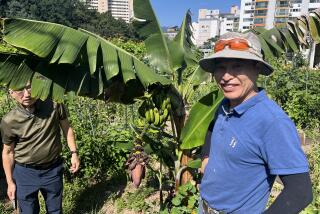Top Banana : Tons of the Fruit Are Unloaded Weekly at Port Hueneme Docks
The banana boats from Ecuador and Costa Rica dock once a week at Port Hueneme to unload their cargo--without brawny, singing stevedores or the legendary stowaway tarantulas.
Instead, the green “hands” of bananas leave the massive, floating refrigerators in neatly stacked boxes several tons at a time, moved ashore swiftly by longshoremen in a mechanized ballet of cranes and forklifts.
The dance floor is Dock No. 1 at Port Hueneme, run by Del Monte, the third largest importer of bananas in the United States, after Dole and Chiquita.
Port Hueneme is Del Monte’s sole West Coast port for incoming bananas.
Last year Del Monte moved 123,749 metric tons of the sweet fruit off freighters and onto waiting refrigerator trucks for sale throughout the West.
“Del Monte’s been here since ‘79,” James Dawson, the company’s port manager, said. “We like being here because of the quality of the labor. The L.A./Long Beach/San Pedro complex has become so dependent on shipping containers. But the labor here is extremely well-conditioned to palletized cargo.”
Long gone are the days when broad-shouldered dockhands would unload mammoth banana bunches from huge piles of fruit in the hold, operations manager Kevin Lee said.
Gone, too, are the tarantulas that sometimes stowed away inside the bunches, he said.
Now, Del Monte’s farmers in South and Central America lop the bunches from the trees and cut them into “hands” of seven or eight bananas, after inspecting them for bruises and eight-legged hitchhikers.
Workers then pack the hands into cardboard boxes--each stamped with the farm’s identification number. Del Monte ships its own fruit and bananas for the smaller Turbana Banana Co. to Port Hueneme for shipment around the West Coast, Dawson said.
The 44-pound boxes are stacked onto wooden pallets, wrapped in nylon cargo netting and loaded aboard ships such as the 370-foot-long, 5,500-ton Baltic Star, which docked Monday at Port Hueneme. There, members of the International Longshoremen’s and Warehousemen’s Union and the Teamsters Union unload the ships.
Tuesday, the Del Monte crew moved through the Baltic Star’s hold like an intricate machine, moving nearly 50,000 boxes of bananas.
Using forklifts, four longshoremen simultaneously shifted heavy stacks of banana boxes out of the tightly packed rows of pallets.
As the forklifts converged on the center of the hold, the operator of the shipboard crane lowered a cargo cage through the yawning hatch.
The cage hit the corrugated deck with a clang.
That was the cue. The four forklifts nudged the pallets of bananas into a tight cube in the cage and withdrew.
As soon as the steel forks were clear, the crane operator swung the cage up, out of the hatch and down to the dock, where two double-width forklifts shifted the pallets in pairs from the cage to the loading dock.
There, the Teamsters Union took over, shuttling the pallets onto waiting refrigerated semitrailers--960 boxes per trailer--for shipment to supermarkets and wholesalers.
At one point, the wheel of longshoreman Jay Lopez’s loaded forklift slipped into a chink between the deck plates, tipping his load.
With a crunch, one corner of the wooden pallet collapsed, threatening to pitch the stack of banana boxes onto the floor.
Hatch boss Jack Olivera quickly ordered another loaded forklift into place, and longshoreman John Lewandowsky’s loaded forklift pirouetted into position. Lewandowsky used his load as a brace to push Lopez’s load upright again, allowing Lopez to drive away and another worker to slip a steel plate over the gap in the deck.
In less than 90 seconds, the mishap was over, and the careful movement of bananas from ship to shore continued.
“The people we get are generally very good,” Dawson said. “It’s a very efficient operation.”
On the dock, Del Monte fruit inspectors were busy pulling boxes from each pallet to inspect the fruit for any bruises or stains that might have occurred in shipment.
The smooth, firm fruit was a jungle green that would turn to the familiar yellow within three days. The inspectors measured the fruit’s thickness and length and occasionally broke one open to make sure that juice oozed out slightly, which indicated that it had made the voyage at a constant 56 to 60 degrees Fahrenheit, Lee said.
“It’s very delicate,” Lee said of the banana-shipping process. “If you don’t do anything bad to the outside, nothing’s going to go wrong on the inside.”
More to Read
Sign up for The Wild
We’ll help you find the best places to hike, bike and run, as well as the perfect silent spots for meditation and yoga.
You may occasionally receive promotional content from the Los Angeles Times.






